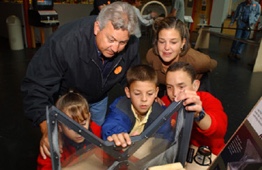 | Exploratorium. A theology professor brought students there to learn about and to write a paper on the implications of perceptual foibles on philosophy. People have used the exhibits in the Exploratorium in the process of writing a book or of making films or television shows. A group that concentrates on teaching sensorially handicapped children arranged several classes at the Exploratorium for the parents of these children. A dozen or so exhibits illustrating, for example, reverse distance cues or delayed speech effects were selected for study so that the parents could get some feeling for the frustrations that their children were experiencing. In addition to our exhibits, we have demonstrations and talks. Our artists-in-residents talk about their work not only to our staff members but to many of our visitors and to local artists. Dr. Tom Humphrey, after he left the Exploratorium, taught classes at the Exploratorium for the College of Mann and for the Art Institute and for the Art Academy which fulfilled the science requirement for those schools. Our staff members have, on a number of occasions, taught courses for college, junior high or high school. We have an ongoing program of teacher workshops for elementary school instruction. The Sigma Psi at San Francisco State University organized a weekend during which a dozen faculty researchers set up some of their apparatus and arranged booths that enabled them to show their data and to explain to our visiting public what their research was all about. Last year for a period of six months, six different groups of doctors, nurses and technicians set up collections of medical instrumentation and equipment in the Exploratorium. Each subject remained on display for a month. The doctors, technicians and practitioners were on hand during weekends to explain the basic medicine and the medical instrumentation and also to answer questions. In this instance also, the Exploratorium provided an opportunity for professionals to become teachers of the general public. Many of the exhibits that we have on display were commissioned from the people who came to us with an idea or a | ||
knowledge or expertise to teach their children and talk about things to which the children probably would not pay attention were it not for their captivation by and delight in the demonstrations and props in the Exploratorium. Sometimes the effects are overdone. I have observed mothers who would not let their children touch an exhibit until they had read out loud every bit of the graphics. On one occasion a father who, when his child came running to him with: "Hey dad, come look at this," said to the boy, "You're disgusting, I brought you here because I know about this stuff and I want to show it to you, not the other way around!" Continually, in the Exploratorium, one sees and overhears people explaining, often somewhat unorthodoxly, things to their friends, wives, husbands or children. Classroom teachers, of course, also use the Exploratorium as a part of their teaching. Many of them prepare worksheets or ask the students to find specific exhibits and to describe how they work. A college instructor wrote a laboratory manual during his sabbatical that enabled him to use the Exploratorium exhibits as a laboratory for his intersession courses for teachers. A sixth grade instructor allowed his gifted student class to undertake a spring semester project that consisted of making a film at the Exploratorium. Many college and university faculty either send their students to the Exploratorium or bring them there on specially arranged tours that provide an overview of their course work on, for example, visual perception, optics or neurophysiology. One architecture professor assigned his students a task of designing a pleasant sitting area for the | |||